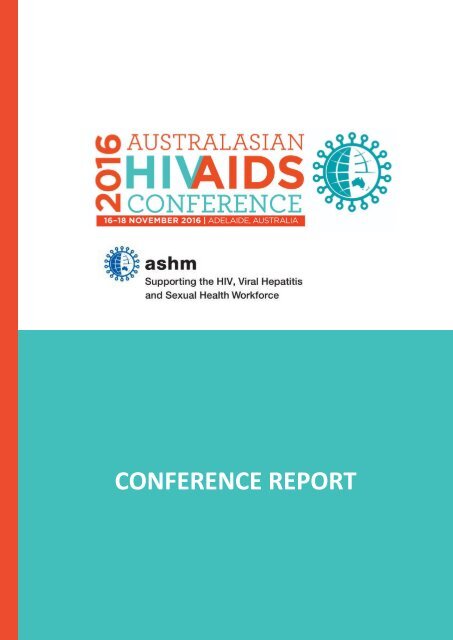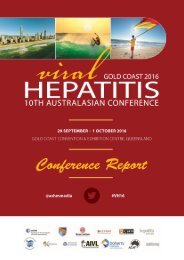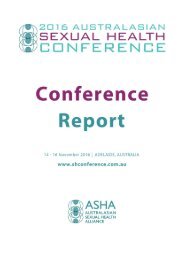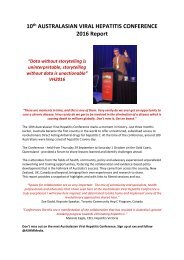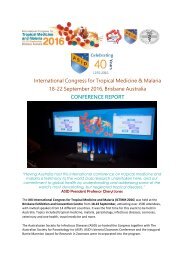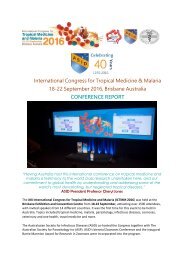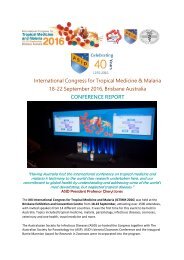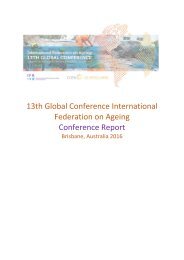AUSTRALASIAN HIV CONF REPORT 2016_FINAL
The Australasian HIV & AIDS Conference, run by ASHM, presents new and innovative research from across the Australasian HIV sector. Delegates include researchers, clinicians, policy makers, community organisations and activists. This 2016 Conference Report provides a collection of key learnings, with links to abstracts and presentations.
The Australasian HIV & AIDS Conference, run by ASHM, presents new and innovative research from across the Australasian HIV sector. Delegates include researchers, clinicians, policy makers, community organisations and activists. This 2016 Conference Report provides a collection of key learnings, with links to abstracts and presentations.
Create successful ePaper yourself
Turn your PDF publications into a flip-book with our unique Google optimized e-Paper software.
<strong>CONF</strong>ERENCE <strong>REPORT</strong>
“The research presented at the Australasian <strong>HIV</strong><br />
& AIDS Conference has a profound impact on<br />
policy, helping to forge evidence-based responses<br />
to <strong>HIV</strong> in our region. We urge you to read and<br />
share this report, so that our national and<br />
regional programs continue to be guided by<br />
latest research, and the collaborative efforts of<br />
community, clinicians and researchers.”<br />
Adjunct Associate Professor Levinia Crooks AM<br />
Chief Executive Officer – ASHM<br />
A note about the report:<br />
The purpose of this report is to capture highlights from the <strong>2016</strong> Australasian <strong>HIV</strong> & AIDS<br />
Conference and to provide a tool to share research presented there. Only a small number of<br />
research papers are included. For the full list of presentations please visit the Conference<br />
Program page, and click on the ‘more info’ tabs for links to abstracts and presentations.<br />
Within this document, research paper titles underlined in orange are hyperlinked to related<br />
abstracts. Presentation slides are also included where available.<br />
We hope you enjoy the report and encourage you to share it widely with colleagues.<br />
1
CONTENTS<br />
Overview from Australia 03<br />
Opening Plenary 04<br />
<strong>HIV</strong> Surveillance Reports 05<br />
Testing, Treatment & Cascade of Care 06<br />
PrEP 09<br />
Science/Cure Research 11<br />
Diversifying Epidemics/Priority Populations 13<br />
Politics, Policy, Culture 15<br />
Anal Cancer 16<br />
International 18<br />
Community Highlights 20<br />
Media Coverage/Social Media 21<br />
From ASHM 23<br />
2017 Australasian <strong>HIV</strong> Conference 25<br />
Thanks to our Sponsors 26<br />
SAVE THE DATE FOR 2017 IN CANBERRA!<br />
Further your professional development by becoming an ASHM Member today or keep up with latest<br />
developments in <strong>HIV</strong>, Viral Hepatitis and Sexual Health with our free newsletter ASHMNews. Sign up<br />
through the ASHM homepage.<br />
2
Bridget Haire, AFAO President and post-doctoral research fellow,<br />
the Kirby Institute<br />
“Our states and territories differ considerably when it comes to providing an<br />
enabling environment for health. This is a real problem, given that the<br />
commonwealth is disinvesting, particularly in the community sector.”<br />
Associate Professor James Ward, South Australian Health<br />
and Medical Research Institute<br />
“These statistics regarding <strong>HIV</strong> in Aboriginal and Torres Strait Islander peoples<br />
are Australia's wake up call. The danger of <strong>HIV</strong> spreading within communities<br />
with such a high prevalence of STIS is simply too great to be ignored.”<br />
Dr Jared Baeten, Vice Chair and Professor, University of Washington, USA<br />
“There is an encouraging pipeline of new PrEP prevention products that will<br />
deliver additional options. However, we would be naïve to imagine that any<br />
one of these will work or be workable for every person.”<br />
Robert Mitchell, Vice President NAPWHA<br />
“If we are to change the trajectory of <strong>HIV</strong> transmissions, we must remove the<br />
barriers to testing and treating. We have all the tools at our disposal; we have<br />
the knowledge and we have the expertise. What we need is the political will.<br />
Australia is close to virtually eliminating <strong>HIV</strong>; now is not the time to ease back,<br />
we must push forward.”<br />
OVERVIEW FROM AUSTRALIA<br />
OPENING PLENARY<br />
Bridget Haire, AFAO President and post-doctoral research fellow, the Kirby Institute<br />
“This conference is an unparalleled opportunity for us to get together – community, clinicians and<br />
researchers – and really focus on the key issues that face us in our national and regional response to<br />
<strong>HIV</strong>. And there’s a lot that we need to talk about:<br />
In <strong>2016</strong> in Australia, we have the tools to end the epidemic, but these are selectively and unequally<br />
distributed. States and territories differ considerably when it comes to providing an enabling<br />
environment for health.<br />
The lack of a unified national approach for <strong>HIV</strong> is troubling.<br />
National community peak organisations have experienced dire funding cuts that threaten our world<br />
famous partnership between community, research and government.<br />
We need to continue to advocate for nationally based approaches to <strong>HIV</strong> care and prevention, and to<br />
ensure that disadvantaged populations get the attention they need and deserve.<br />
Read Bridget Haire’s welcome to the <strong>2016</strong> Australasian <strong>HIV</strong> & AIDS Conference.<br />
3
OPENING PLENARY: <strong>HIV</strong> DIVERGENCE<br />
Associate Professor James Ward, Head Infectious Diseases Aboriginal Health, South Australian<br />
Health and Medical Research Institute, SA, Australia (SAHMRI)<br />
<strong>HIV</strong> RATES IN INDIGENOUS AUSTRALIANS AT ALL TIME HIGH<br />
Australia’s <strong>HIV</strong> and Hepatitis C success overshadowed by Aboriginal and Torres Strait Islander neglect<br />
New national statistics released from the <strong>2016</strong> Australasian <strong>HIV</strong> & AIDS Conference revealed that <strong>HIV</strong> in<br />
Aboriginal and Torres Strait Islander people are at an all-time high, with 2015 seeing the highest number<br />
diagnosed with <strong>HIV</strong> since 1992.<br />
The rate of <strong>HIV</strong> notification among Aboriginal and Torres Strait Islander people is now more than double<br />
the rate in non-Indigenous Australians, and has increased each year for the last five years.<br />
Other sexually transmissible infections in Indigenous Australians such as chlamydia, gonorrhoea and<br />
infectious syphilis are on average 3, 10 and 6 times higher respectively, and hepatitis C is 4 times higher.<br />
The gap even more significant in some remote communities.<br />
“This is absolutely unacceptable,” said Associate Professor James Ward, South Australian Health and<br />
Medical Research Institute (SAHMRI). “At a time when Australia is showered in praise for being a world<br />
leader in <strong>HIV</strong> and hepatitis C prevention, one of our priority populations is being left behind.”<br />
Read the full media release.<br />
Watch James’ live interview on ABC TV News.<br />
View the media coverage book for links to additional coverage on this topic.<br />
In his opening plenary, James Ward examined why this divergence is occurring and who is most<br />
affected:<br />
Demographics (young, mobile and more regional and remote residents)<br />
Risks (sharing of injecting equipment, high background prevalence of STIs)<br />
Success in non-Indigenous diagnosis<br />
Failure to engage TasP and PreP in community<br />
Key Messages re <strong>HIV</strong> in Aboriginal and Torres Strait Islander Populations<br />
<strong>HIV</strong> is increasing<br />
We’re at a critical point in the epidemic<br />
Engaging in PrEP and TasP will take significant time and investment of all sectors<br />
Combination prevention will still be required for some time to come<br />
It’s all our responsibility but Aboriginal and Torres Strait Islander peoples need to drive it.<br />
“We need to be very strategic. There is a need for a national strategy for the Aboriginal Medical<br />
Services sector to ensure all jurisdictions are on the same page. If we could get everybody who<br />
should be tested, tested within the appropriate timeframe and in an appropriate manner then I<br />
think we would be doing very well. Right now, these advances in medicine and technology are<br />
creating a bigger divergence in <strong>HIV</strong> diagnosis. New technologies benefit and advance the most<br />
privileged and leaves the marginalised behind.”<br />
View the presentation slides<br />
4
<strong>HIV</strong> SURVEILLANCE <strong>REPORT</strong>S - 2015 DATA<br />
THE KIRBY INSTITUTE: ANNUAL <strong>HIV</strong> SURVEILLANCE <strong>REPORT</strong> – Key findings 2015<br />
Number of new <strong>HIV</strong> notifications stable for 4 years, with 1 025 new infections in 2015.<br />
Breakdown of notifications:<br />
o 68% gay and bisexual men (GBM);<br />
o 20% heterosexual sex;<br />
o 5% sexual contact between men and injecting drug use;<br />
o 3% injecting drug use only.<br />
29% of new notifications classified as late diagnoses; that is, they were likely to have had <strong>HIV</strong> for at<br />
least 4 years without being tested.<br />
Proportion of late diagnoses in GBM / GBM + IDU has declined (27% to 20%).<br />
<strong>HIV</strong> notification in Aboriginal and Torres Strait Islander people is more than double the rate in the<br />
Australian-born non-Indigenous population (6.8 versus 3.1 per 100 000). Transmission through<br />
heterosexual sex (21%) or IDU (16%) in this population is higher.<br />
Prevalence<br />
0.1% of Australians are living with <strong>HIV</strong>.<br />
<strong>HIV</strong> prevalence remains very low in people who inject drugs (PWID).<br />
Testing and Care<br />
25 313 Australians are living with <strong>HIV</strong>. Of these, 90% have been diagnosed, 85% are in care, 75%<br />
are receiving ARVs, and 69% have achieved viral suppression.<br />
In the past five years, testing coverage has increased significantly in GBM with 61% reporting an <strong>HIV</strong><br />
test in the past 12 months.<br />
Testing frequency in GBM attending clinical services (ACCESS) has also increased from an average of<br />
1.1 <strong>HIV</strong> tests per year in 2011 to 1.4 in 2015.<br />
<strong>HIV</strong> Incidence<br />
<strong>HIV</strong> incidence remains extremely low among female sex workers, with no <strong>HIV</strong> cases detected in the<br />
past 2 years.<br />
ANNUAL <strong>REPORT</strong> OF TRENDS IN BEHAVIOUR – <strong>HIV</strong> <strong>2016</strong><br />
UNSW’s Centre for Social Research in Health<br />
The high proportion of <strong>HIV</strong>+ GBM on ARVs is making treatment as prevention a reality.<br />
<strong>HIV</strong> prevention is growing in complexity with breadth of prevention tools available.<br />
Apart from consistent condom use, GBM look to other prevention strategies to avoid acquiring <strong>HIV</strong>.<br />
Condomless anal sex with casual partners has increased among GBM, particularly under 25s.<br />
Increase in STIs brings new challenges.<br />
Urgent need for <strong>HIV</strong> prevention messages to reflect expanding approaches gay men find most<br />
suitable. Messages should include biomedical and behavioural tools and address diverse groups of<br />
gay men.<br />
“While high rates of treatment uptake and condom use among gay men must be sustained,<br />
priorities should be given to make new prevention tools, like PrEP, more accessible through<br />
reimbursement on the Pharmaceutical Benefits Scheme (PBS).”<br />
Associate Professor Martin Holt, the project leader of the Gay Community Periodic Surveys at<br />
CSRH.<br />
5
TESTING, TREATMENT & CASCADE OF CARE<br />
Australia’s <strong>HIV</strong> epidemic continues to be predominantly in men who have sex with men, with stable<br />
rates in the past ten years. Overall, initiatives to promote and improves access to testing have achieved<br />
higher levels of testing coverage and frequency and reduced the proportion diagnosed late with <strong>HIV</strong>.<br />
Treatment coverage has increased considerably, and there has been a corresponding increase in the<br />
proportion of people with undetectable viral load, decreasing the chance of <strong>HIV</strong> transmission.<br />
Annual Surveillance Reports <strong>2016</strong><br />
TAKE HOME MESSAGES<br />
Professor Jennifer Hoy, <strong>HIV</strong> Medicine, Alfred Hospital/Monash University<br />
1. We need to facilitate increased frequency of <strong>HIV</strong> testing in gay and bisexual men<br />
(GBM) in Australia.<br />
2. We need timely and better quality data to understand the cascade in Australia.<br />
3. We need to urgently address increasing <strong>HIV</strong> infections in the Indigenous population,<br />
and urgently provide culturally appropriate, geographically accessible and<br />
Indigenous-led prevention packages.<br />
4. Rates of ARV treatment in those who know they are <strong>HIV</strong> positive are less than<br />
UNAIDS 90:90:90 targets, while rates of virological suppression have reached<br />
targets.<br />
5. Rates of new <strong>HIV</strong> infections in Australia remain stable, despite increases in testing<br />
and treatment.<br />
TESTING<br />
Overview:<br />
Overwhelming majority of testing in Australia continues to occur in primary care settings, by<br />
clinicians using serological laboratory testing.<br />
We don’t know how much we might need to increase testing by but probably a lot.<br />
Will require innovation in <strong>HIV</strong> testing models<br />
So far, PoCT has made a small but critical contribution to the increase in <strong>HIV</strong> testing in Australia.<br />
Most men say they are likely to test more often if self-testing available.<br />
Australia has been very behind the times with <strong>HIV</strong> PoCT - other countries are moving forward with<br />
self-test programs.<br />
There are a number of new PoCT tests on the horizon, including nucleic acid tests.<br />
What we know about testing:<br />
Guidelines (STIGMA) recommend annual testing in all GBM; 3-6 monthly testing if high risk.<br />
27% increase in <strong>HIV</strong> testing in the last 5 years.<br />
87% GBM have ever tested (GCPS).<br />
53% re-test in 12 months (ACCESS NSW 2014).<br />
54% higher risk men re-test in 6 months (ACCESS NSW 2014).<br />
10-12% <strong>HIV</strong> undiagnosed (Holt 2014; Mallitt 2012).<br />
31% infections transmitted by undiagnosed (Wilson 2009).<br />
50% people surveyed from CALD background in NSW ever tested (CALD survey).<br />
6
Self-Specimen Collecting<br />
NSW pilot study just launched for self-specimen collection with laboratory testing:<br />
o Mail out collection kit for Dried Blood Spot (DBS) testing in priority populations. Specimens<br />
posted to lab.<br />
o GBM and people from African + Asian countries, and/or have had previous sexual or injecting<br />
partner from one of these countries are now able to order it for free in NSW.<br />
o The project is a partnership between the Sexual Health Infolink, St Vincent’s <strong>HIV</strong> Reference<br />
Laboratory and the Ministry of Health Service.<br />
o Mail out DBS has been available in the US since 1996 and performed very well in the UK.<br />
o Involves conventional laboratory confirmation including nucleic acid tests.<br />
Self-Testing (immediate results)<br />
Self-tests currently on the market in other countries include those that involve capillary blood<br />
specimens and oral fluid specimens.<br />
From a regulatory and program implementation approach, the development of self-testing in<br />
Australia needs to consider the cost-benefit of adopting lower performance tests that are less<br />
invasive and potentially more acceptable (oral fluid tests) versus higher performance tests that are<br />
more invasive and potentially less acceptable (blood specimen).<br />
The balance for <strong>HIV</strong> prevention is ensuring infections are not missed (performance of tests) while<br />
expanding the reach and frequency of testing (acceptability of tests).<br />
BioSure <strong>HIV</strong> self test is an example of a self-test available in the UK that does not require lab testing.<br />
Community Testing<br />
Only about 60 PoCT services currently registered in Australia on the ASHM Testing Portal.<br />
10 community-based services.<br />
Integrating STI testing and parallel <strong>HIV</strong> serology has been an issue.<br />
Challenge is in identifying acute not established infections.<br />
Conclusion:<br />
o Key for standalone rapid tests (through service or at home) is frequency<br />
o PoCTs may be “less sensitive than a 4th generation assay but more sensitive than a test that<br />
doesn’t happen”.<br />
RELATED RESEARCH<br />
Innovative ways to improve the demand for testing – update on the technology and review of<br />
programs and novel implementation opportunities<br />
Philip Cunningham; Mark Stoove<br />
o An overview of latest developments in PoCT, self-testing and lab innovation.<br />
a[TEST] Oxford Street: A Successful Model of Community Rapid <strong>HIV</strong> Testing in Sydney / Effect<br />
of an Express Testing Service for Gay and Bisexual Men on <strong>HIV</strong> Testing Frequency<br />
Vickie Knight, Sydney Sexual Health Centre<br />
o Service attendees complete demographic/risk questionnaires via computer assisted selfinterview.<br />
Peer educators offer a <strong>HIV</strong> rapid test and self-collected STI tests and the nurse<br />
performs concurrent <strong>HIV</strong>/syphilis serology. The <strong>HIV</strong> rapid test results are given within 10<br />
minutes and others sent via text, phone or email.<br />
o Of 5388 GBM attendees, 5011 (93%) had an <strong>HIV</strong> test performed. 46 were newly positive (0.9%)<br />
and 643 (11.9%) were diagnosed with at least one bacterial STI. Almost one third (31%)<br />
reported more than five partners in the previous three months and approximately half (44%)<br />
reported inconsistent condom use with casual partners.<br />
7
TREATMENT & CARE CASCADE<br />
Key Messages: Ethical considerations in treatment culture<br />
The decision to start treatment is a personal one, it should be an informed one, and<br />
made with the health care provider.<br />
Starting treatment on the same day as <strong>HIV</strong> diagnosis is associated with reduced period<br />
of infectiousness, but increased rates of regimen change and disengagement from<br />
care.<br />
Peer support is very important in decision making around treatment, and in providing<br />
support when treatment starts.<br />
RELATED RESEARCH<br />
Mind the gap: Progress towards treatment for all and its impact on prevention<br />
Keynote Speaker Dr Valerie Delpech<br />
CD4 counts are still important. It's not good enough to put everyone diagnosed on treatment: it<br />
needs to be early. Without CD4 count you won't know how long they've been carrying the disease.<br />
Treatment as prevention is reducing incidence but we also need investment in primary prevention.<br />
Globally, <strong>HIV</strong> data is very poor.<br />
Some countries are making great progress towards viral suppression but for others it’s out of reach.<br />
In Eastern European the majority of new infections are now in heterosexuals (used to be PWID).<br />
Currently, we’re at about 50% of diagnosed targets, 40% on treatment targets so have a long way to<br />
go before we reach UN targets of 90:90:90.<br />
You have <strong>HIV</strong> and you must start treatment today" - how urgent is the need to start?<br />
Prof Jennifer Hoy, Professor Director, <strong>HIV</strong> Medicine, Alfred Hospital and Monash University<br />
Same day ART should be facilitated for those who request it.<br />
ART initiation should occur when the individual is ready to start – informed decision.<br />
Most clinicians prefer being armed with baseline test results to individualise ART – this takes 1-3 weeks –<br />
this time does not make a significant difference to outcomes, either personal or <strong>HIV</strong> prevention.<br />
Comparing <strong>HIV</strong> Viral Load and CD4 Counts for People Retained in Care to People with<br />
Unknown Outcomes<br />
James McMahon, Alfred Health and Monash University<br />
People with unknown outcomes - including those who re-engage or transfer care - are at risk for<br />
worse clinical outcomes and onward transmission. These individuals should receive interventions to<br />
improve virological suppression across this population. View the presentation slides.<br />
Women, Those Who Inject Drugs + Younger People More Likely to Have 'Detectable' Viral Loads<br />
Denton Callander, The Kirby Institute<br />
Women, younger people, and IDU are more likely than other patients to have a detectable viral load,<br />
suggesting that they may require further support to maintain <strong>HIV</strong> treatment. Collaborative solutions<br />
to improve treatment adherence are warranted. View the presentation slides.<br />
Fall in Time from <strong>HIV</strong> Diagnosis to Commencement of Antiretroviral Therapy 2011-2015<br />
Nicholas Medland, Melbourne Sexual Health Centre, Central Clinical School, Monash University<br />
Time to ART is a convenient and readily available indicator which centres should consider to supplement<br />
<strong>HIV</strong> care cascade results, to measure progress toward treatment as prevention goals. This study looked<br />
at significant reduction in time between diagnosis and treatment initiation in 2 clinics in Melbourne.<br />
8
PrEP<br />
More than 27,000 Australians are living with <strong>HIV</strong> and PrEP is a potential game-changer, but it can be<br />
frustratingly difficult to access. In August <strong>2016</strong> the PBAC rejected the application by Gilead Sciences to<br />
list Truvada for PrEP on the Pharmaceutical Benefits Scheme (PBS), saying price submitted by the<br />
sponsor was too high.<br />
AFAO says the federal government will not meet its target of ending <strong>HIV</strong> transmission by 2020 unless<br />
PrEP is subsidised through the PBS.<br />
Read ASHM’s announcement on the PBAC’s rejection<br />
Read an update on PrEP for clinicians<br />
Find out about 3 ways to access PrEP in Australia<br />
TAKE HOME MESSAGES<br />
Associate Professor Martin Holt, Centre for Social Research in Health, UNSW<br />
1. International experience indicates PrEP is highly effective, but broadening access and<br />
managing STIs remain hot topics<br />
2. In Australia, growing use of PrEP by thousands of mainly in NSW/VIC, but we are<br />
waiting to see effects on the epidemic.<br />
3. In Australia, poor access outside NSW/VIC is preventing wider benefits of PrEP being<br />
realised.<br />
4. PrEP users report profound relief from anxiety about <strong>HIV</strong>, greater security in being <strong>HIV</strong>negative<br />
when on PrEP.<br />
5. The roll out of PrEP is making condom use/negotiating sex more difficult for some;<br />
identifying successful ways to negotiate combination prevention is important.<br />
RELATED RESEARCH<br />
PrEP at age 6<br />
Keynote Speaker: Dr Jared Baeten, Vice Chair and Professor, University of Washington, USA<br />
International experience indicates PrEP is highly effective, but broadening access and managing STIs<br />
remain hot topics. Read the ASHM Report back.<br />
It’s taken a village: PrEP in Victoria<br />
Edwina Wright, Infectious Diseases Specialist, Alfred Health, VIC<br />
Growing use of PrEP in VIC (by thousands of mainly GBM) – waiting to see impact on epidemic.<br />
Targeted implementation of PrEP in NSW<br />
Iryna Zablotska-Manos, The Kirby Institute<br />
Massive uptake (over 4000) of PrEP in NSW by people at high risk. No <strong>HIV</strong> infections, but increased<br />
condomless sex and STIs.<br />
9
The changing experiences of negotiating sex with (potential) partners for men using PrEP<br />
Dean Murphy, Research Fellow, Centre for Social Research in Health, UNSW, Australia<br />
PrEP users report profound relief from anxiety about <strong>HIV</strong>, greater security in being <strong>HIV</strong>-negative<br />
when on PrEP. PrEP also represents a strategy through which a more active consumer of prevention<br />
emerges.<br />
Do we have the courage and ambition to end <strong>HIV</strong> in Australia? Examining our progress and<br />
prospects through the case of PrEP<br />
Darryl O'Donnell, Australian Federation of AIDS Organisationsb (AFAO), Australia<br />
Demands for better testing options and technologies, PrEP, and easier, cheaper access to treatment,<br />
has seen renewed focus on supply-side problems in <strong>HIV</strong>. In Australia, poor access outside timelimited<br />
State and Territory clinical trials is preventing wider benefits of PrEP being realised.<br />
Considerable advocacy work remains.<br />
What PrEP Means for Safe Sex in Sydney: Evolving Norms<br />
Bridget Haire, Kirby Institute.<br />
While PrEP has been readily adopted by some gay men, others are grappling with new framings of ‘safe<br />
sex’ and the development of new norms, making condom use/negotiating sex more difficult for some.<br />
View the presentation slides.<br />
10
SCIENCE/CURE RESEARCH<br />
TAKE HOME MESSAGES from Professor Damian Purcell, Doherty Institute<br />
1. Epigenetic modifying drug, Vorinostat, increased RNA expression of numerous cellular<br />
genes in addition to <strong>HIV</strong>. However long-term follow-up showed that gene expression<br />
returned to normal after 24 months, supporting safety of the histone deacetylase<br />
inhibitors.<br />
2. New drug candidates are under development that are highly specific for activation of<br />
<strong>HIV</strong> gene expression.<br />
3. Genetic therapies that lock <strong>HIV</strong> into a dormant state without any expression are<br />
advancing through pre-clinical testing.<br />
4. Scientists working in <strong>HIV</strong>-1 cure acknowledge that a successful curative therapy for<br />
everybody is 10-15 years away.<br />
5. Significant advances have been made with <strong>HIV</strong> vaccines to prevent transmission for the<br />
uninfected.<br />
Where are we with the Cure? Science, Trials and Community – Key Messages<br />
It’s going to take a long time before we develop <strong>HIV</strong>-curative therapies that eliminate the residual<br />
levels of <strong>HIV</strong>.<br />
Drugs currently under investigation generally lack sufficient <strong>HIV</strong>-specificity and potency to reveal<br />
latent <strong>HIV</strong> for clearance.<br />
Gene therapy approaches are in development to silence the relatively small amount of residual<br />
replication competent <strong>HIV</strong>.<br />
Approaches that evoke potent anti-<strong>HIV</strong> immune effector responses show promise in prevention and<br />
<strong>HIV</strong> cure.<br />
<strong>HIV</strong> Persistence and Latency – Key Messages<br />
<strong>HIV</strong> vaccines based on poxvirus vectors are showing promise for prevention of transmission, and for<br />
control of <strong>HIV</strong> during infection.<br />
New assays to measure antibodies capable of directing ADCC-mediated killing of infected T-cells will<br />
help in assessing <strong>HIV</strong> vaccine candidates and eliminating latent <strong>HIV</strong> infected cells.<br />
HDACi drugs have effects on many cellular genes, in addition to <strong>HIV</strong>-1, but changes in gene<br />
expression normalise during long term follow up.<br />
RELATED RESEARCH<br />
What is the Science Telling Us?<br />
Prof Anthony Kelleher, Kirby Institute, NSW, Australia<br />
The levels of latent <strong>HIV</strong> capable of reactivating infection after interruption of therapy are very small.<br />
Genetic therapies that lock this subset of latent <strong>HIV</strong> into dormant state are advancing towards<br />
through pre-clinical testing.<br />
This is an exciting technology, but uses a very sophisticated gene therapy delivery system that will be<br />
too expensive to scale up for universal access.<br />
11
What do the Clinical trials and cohorts tell us?<br />
James McMahon, Alfred Health and Monash University<br />
It is difficult to find the latent <strong>HIV</strong> that has capacity for replication competence. Current drugs that<br />
have completed trial have been encouraging, but have too low a specific activity for <strong>HIV</strong> to be<br />
successful cure therapies at this time. View the presentation slides.<br />
Antimicrobial and Immune Modulatory Effects of Vaginal Microbiota Acid Metabolites and<br />
<strong>HIV</strong> Susceptibility<br />
A/Prof Gilda Tachedjian, Associate Professor, Burnet Institute, Australia<br />
The commensal microbial flora plays an important role in the susceptibility for <strong>HIV</strong> transmission to<br />
women. Lactic acid from some bacteria is protective.<br />
Examining the Role of Human Dendritic Cells in Mediating Sexual Transmission of <strong>HIV</strong><br />
Andrew Harman, The Westmead Institute for Medical Research, The University of Sydney<br />
Different dendritic and macrophage subsets in the different regions of the sexual mucosae are<br />
responsible for mediating <strong>HIV</strong> transfer to CD4+ T-cells during <strong>HIV</strong> transmission. View the<br />
presentation slides.<br />
<strong>HIV</strong> vaccine-induced protective antibodies: lessons from the sacred cow<br />
Damian Purcell, The Doherty Institute<br />
Large scale production of <strong>HIV</strong>-neutralising antibody has been obtained from colostrum of cows<br />
vaccinated with <strong>HIV</strong> gp140 trimers. This has produced sufficient antibody to produce a preventive<br />
vaginal microbicide for clinical trials in women.<br />
New Latency Reversing Agents specifically targeting <strong>HIV</strong> provirus positive cells<br />
Jonathan Jacobson<br />
New compounds that specifically reactivate <strong>HIV</strong> from latency act on novel targets + are synergistically<br />
active with some of the known latency reversing agents that target epigenetic control pathways.<br />
Partial efficacy of a broadly neutralizing antibody against cell-associated S<strong>HIV</strong> infection<br />
Kevin John Selva, The Peter Doherty Institute for Infection and Immunity<br />
New plate based assay for antibodies that perform ADCC functions. These use soluble protein<br />
components to identify antibodies that correlate with <strong>HIV</strong> protection in the RV144 vaccine trial.<br />
What’s in it for me? Balancing hope and healthy scepticism about <strong>HIV</strong> cure research<br />
Brent Allan, Executive Officer, Living Positive Victoria<br />
Scientists working in <strong>HIV</strong>-1 cure acknowledge that a successful curative therapy for everybody is 10-<br />
15 years away.<br />
Novel <strong>HIV</strong>-1 glycoprotein vaccine with enhanced exposure of broad neutralization epitope<br />
Andrew Poumbourious<br />
Made an <strong>HIV</strong> Envelope gp140 trimer vaccine that was successful in raising neutralising antibodies in<br />
animal studies.<br />
No adverse safety or virological changes 2yrs following a short course of vorinostat in <strong>HIV</strong>infected<br />
individuals on ART<br />
Talia Mota, Peter Doherty Institute of Infection and Immunity<br />
Clinical trial with Vorinostat demonstrated an increased expression of <strong>HIV</strong> RNA as well as RNA<br />
transcribed from numerous other cellular genes. However gene expression levels returned to normal<br />
after long term follow up, supporting safety of the histone deacetylase inhibitor (HDACi) class of<br />
epigenetic modifying drugs.<br />
Pre-clinical evaluation of a mucosal <strong>HIV</strong> vaccine strategy<br />
Charani Ranasinghe<br />
Potent <strong>HIV</strong> vaccines that use the poxvirus vector system to elicit strong mucosal T-cell responses, and<br />
anamnestic antibody responses that will protect against <strong>HIV</strong> transmission.<br />
12
DIVERSIFYING EPIDEMICS/ PRIORITY POPULATIONS<br />
NOTE: The ASHM AGM unanimously endorsed a resolution to provide subsidised antiretroviral<br />
treatment to individuals resident in Australia and New Zealand, irrespective of visa status.<br />
An Overview<br />
<strong>HIV</strong> policies and programs in Australia must adapt to the evolving epidemiology of the infection in<br />
people born overseas, and include culturally appropriate prevention, diagnosis and treatment<br />
services for both GBM and heterosexuals.<br />
Harm reduction strategies to minimise <strong>HIV</strong> transmission among people who inject drugs have been<br />
highly successful and must be sustained.<br />
Extremely low rates of maternal transmission have been achieved through comprehensive medical<br />
interventions.<br />
The incidence of <strong>HIV</strong> among women involved in sex work is among the lowest in the world, due to<br />
highly successful <strong>HIV</strong> prevention for this priority population.<br />
The trend in <strong>HIV</strong> notifications among Aboriginal and Torres Strait Islander peoples highlights the need<br />
to expand access to <strong>HIV</strong> pre-exposure prophylaxis to people who could benefit from this new<br />
technology, and strengthen prevention strategies for these populations.<br />
RELATED RESEARCH<br />
What do we need to better understand the needs of mobile and migrant populations in<br />
Australia? Is a national response achievable?<br />
Lisa Bastian, Program Manager, Western Australian Department of Health, WA, Australia<br />
Men who have men sex with men (GBM)<br />
o Increased proportion of GBM diagnosed with <strong>HIV</strong> were born in Asia<br />
o Asian-born men made up 44% of new diagnoses in 2014 compared to 21% in 2005<br />
Heterosexual people<br />
o 39% of heterosexual transmission were in people from high-prevalence countries or partners<br />
were from high prevalence countries<br />
Pregnant women<br />
o Decreased mother-to-child transmission BUT increased number of deliveries in women with<br />
<strong>HIV</strong> infection<br />
Late and advanced <strong>HIV</strong> diagnoses<br />
o Proportion with late diagnosis was highest in those born in South East Asia (42%) and sub-<br />
Saharan Africa (38%)<br />
Implications for the 8th Australian <strong>HIV</strong> Strategy 2018-21<br />
o Continued inclusion of migrant and mobile populations as a priority<br />
o Consider options for enhanced <strong>HIV</strong> surveillance and monitoring<br />
o Translation of emerging evidence into recommended priority actions<br />
o Greater recognition of stigma, discrimination and structural barriers, including systemic racism.<br />
Read <strong>HIV</strong> and Mobility in Australia Report Card: snapshot of progress and activity<br />
Recent Trends in New Heterosexual Diagnoses of <strong>HIV</strong> in NSW Residents<br />
Meredith Wickens, Health Protection NSW<br />
13
In NSW, heterosexual people are diagnosed with <strong>HIV</strong> later in life and later in their disease than GBM;<br />
<strong>HIV</strong> in People Born Overseas, Australia<br />
Praveena Gunaratnam, The Kirby Institute<br />
This study describes recent <strong>HIV</strong> epidemiological trends in people born overseas, to inform the<br />
development and delivery of targeted and culturally appropriate <strong>HIV</strong> programs. View the<br />
presentation slides.<br />
Prevention of Mother-To-Child Transmission of <strong>HIV</strong> in Australia: An Analysis of 30 Years of<br />
National Surveillance Data<br />
Skye McGregor, The Kirby Institute, UNSW Australia<br />
1986-2015 714 infants born in Australia to <strong>HIV</strong>+ mothers.<br />
37% of were born in Sub-Saharan Africa or South-East Asia, increasing from 11% in 1986-1990 to 46%<br />
in 2011-2015 (p
POLITICS, POLICY, CULTURE<br />
<strong>HIV</strong> <strong>CONF</strong>ERENCE SLAMS SPITTING LAWS<br />
Australia’s leading <strong>HIV</strong> experts have condemned the governments of South Australia, Western Australia<br />
and the Northern Territory over laws that force people accused of spitting at police officers to undergo<br />
mandatory <strong>HIV</strong> and blood-borne virus testing.<br />
Delegates to the Australasian <strong>HIV</strong> Conference unanimously adopted a resolution condemning <strong>HIV</strong><br />
spitting laws in Australia.<br />
TAKE HOME MESSAGES<br />
Bridget Haire, AFAO President and post-doctoral research fellow, the Kirby Institute<br />
1. Australian health care is becoming less equitable, as the state and territory jurisdictions<br />
assume responsibility for what was formerly commonwealth territory.<br />
2. The increase in Aboriginal <strong>HIV</strong> notifications is alarming and requires a coordinated<br />
national approach.<br />
3. Biomedical prevention is changing the way that gay men think about <strong>HIV</strong> status.<br />
4. Providing clear pathways for ARV access for PL<strong>HIV</strong> residing in Australia without<br />
Medicare access remains critical.<br />
5. Australian jurisdictions must cease enacting legislation that implies <strong>HIV</strong> can be acquired<br />
through spitting.<br />
Changing concepts of risk, identity and serostatus - Key Messages<br />
Identity categories based of serostatus are changing with biomedical prevention: ‘on PrEP’ and<br />
‘Undetectable’ are viewed as more meaningful than ‘<strong>HIV</strong> negative’ for negotiating safe sex.<br />
‘Safe sex’ has changed conceptually for some, but not for all sexually active gay men.<br />
‘Combination prevention’ is not a clearly defined or understood practice.<br />
Changes in GBM Condom Use with Casual Partners-NZ<br />
Peter Saxton, University of Auckland<br />
Most surveyed with diagnosed <strong>HIV</strong> did not appear to have dramatically changed their overall rate of<br />
UAIC. However, the proportion engaging in UAIC is substantially higher than that reported among<br />
<strong>HIV</strong> negative GBM. View the presentation slides.<br />
Characteristics of Gay and Bisexual Men Who Use Little To No <strong>HIV</strong> Risk Reduction Strategies<br />
during Condomless Anal Intercourse Johann Kolstee, ACON<br />
Few men used no form of risk reduction.<br />
Most <strong>HIV</strong>+ men practised <strong>HIV</strong> risk reduction.<br />
Younger, <strong>HIV</strong>-negative GBM who used methamphetamine were less likely to use <strong>HIV</strong> risk reduction<br />
strategies, although they may engage in serosorting with casual partners. Given their consistently<br />
high risk behaviour, <strong>HIV</strong> prevention efforts may need to prioritise these men.<br />
View the presentation slides.<br />
Practising Biomedical Prevention Among Gay Men in Serodiscordant Relationships<br />
Steven Philpot, Kirby Institute<br />
Serodiscordant couples were generally well informed about biomedical <strong>HIV</strong>-prevention. However,<br />
they expressed diverse motivations behind utilising these prevention technologies. The <strong>HIV</strong> sector<br />
must continue to engage serodiscordant couples to ensure they are protected from <strong>HIV</strong> in ways that<br />
suit the couple. View the presentation slides.<br />
15
ANAL CANCER<br />
ASHM has commissioned a subcommittee to look at the role of screening for anal cancers in GBM with<br />
<strong>HIV</strong>. Find out more.<br />
TAKE HOME MESSAGES from Associate Professor David Templeton<br />
1. Anal cancer is the most common non-AIDS-defining cancer among <strong>HIV</strong>-positive gay and<br />
bisexual men (GBM).<br />
2. Rates of anal cancer have increased by over 50% in Australia over the last 3 decades.<br />
3. HPV16, the most common cause of anal cancer, is common, persistent and strongly<br />
related to the presence and persistence of anal precancerous lesions.<br />
4. Most GBM in the community have never had a conversation with their doctor about<br />
anal cancer and many believe they are at the same or even lower risk of anal cancer<br />
than the general population.<br />
5. Living through the diagnosis and treatment of anal cancer which presents at a late<br />
stage involves painful, extensive surgery and combination chemo-radiation therapy,<br />
often resulting in long-term complications. This underscores the importance of regular<br />
screening with DARE to pick up cancers at an early stage when treatment is associated<br />
with far less mortality and morbidity.<br />
6. Thus, all <strong>HIV</strong>-positive GBM should have annual digito-rectal examinations (DAREs) for<br />
early detection of anal cancer. A DARE should also be performed whenever a GBM<br />
presents with anal symptoms.<br />
RELATED RESEARCH<br />
Epidemiology of Anal HPV and Anal Cancer<br />
Amber D'Souza, Associate Professor, Johns Hopkins Bloomberg School of Public Health, USA<br />
Incidence of HPV related anal cancer increased by 78% in last 30 yrs in men (US)<br />
Compared with the US general population, <strong>HIV</strong>-negative GBM have a 20-30-fold higher risk of anal<br />
cancer, while <strong>HIV</strong>+ GBM have 100 fold higher risk<br />
Anal pap results in GBM: Abnormal cytology has high sensitivity (~96%) but low specificity (~17%) for<br />
biopsy-proven anal precancerous lesions (= “High-grade squamous intra-epithelial lesions” “HSIL”).<br />
The addition of HPV16 testing to cytology substantially increases the specificity.<br />
What should we be doing for our patients now?<br />
Jason Ong, Monash University, The Alfred - Melbourne Sexual Health Centre, VIC, Australia<br />
Important differences between anal HSIL screening and cervical cancer screening. Not proven that<br />
treating HSIL has led to a decrease in mortality/morbidity. RCTs needed.<br />
Instead, recommend DARE - Annual digital anorectal examination:<br />
o simple, safe, cost effective<br />
16
o 50% anal cancers are externally visible at time of diagnosis and the average tumour size is<br />
2.9cm<br />
o Cancers of 2cm or more usually need chemotherapy. We need to identify tumours before they<br />
grow to this size<br />
o Mortality is very rare if cancers are diagnosed at sixes of 1cm or less.<br />
o Fewer than 10% of <strong>HIV</strong>+GBM currently have annual DAREs<br />
o 86% of <strong>HIV</strong> physicians think it’s important to screen for anal cancer in GBM living with <strong>HIV</strong><br />
o but NONE were screening in a systematic way.<br />
o we're failing our patients by not detecting anal cancers at an earlier stage<br />
Conclusion: All <strong>HIV</strong>+ GBM aged ≥ 50 yrs should be screened for anal cancer annually using DARE<br />
An update of the Study for the Prevention of Anal Cancer (SPANC)<br />
David Templeton, RPA Sexual Health<br />
HSIL –is common occurring in 30-50% of <strong>HIV</strong> positive GBM<br />
Interim SPANC results show great promise in better understanding the natural history of anal HSIL<br />
and identifying a minimally invasive screening program for persistent HSIL<br />
HSIL persistence strongly related to persistent HPV16 positivity<br />
Conclusion: 2 X HPV tests, at least 6 months APART, may identify men with chronic high-risk (i.e.<br />
potentially cancer-causing) HPV infection who are at risk of developing anal cancer.<br />
A community perspective on anal cancer and anal HPV<br />
Lance Feeney, Positive Life NSW, Australia<br />
50% of <strong>HIV</strong>+ GBM think their risk of anal cancer is same or lower than general population.<br />
70% of <strong>HIV</strong>- GBM think their risk is same or lower than the general population.<br />
84% of all respondents and 64% of all <strong>HIV</strong>+ respondents had not had a discussion with their doctor<br />
about anal HPV and anal cancer<br />
For those who have had a conversation with their doctor: > ½ cases it was initiated by the patient.<br />
Only initiated by Dr in about 1/3 of cases<br />
1/3 of respondents are uncomfortable/v uncomfortable discussing anal cancer w/ their Dr<br />
3/4 respondents have never had an anal examination for anal cancer and of the 15% who had, most<br />
had a DARE<br />
70% of all respondents had not been tested for HPV<br />
More than half of respondents were not aware of the HPV vaccine, nearly 90% had not had a<br />
conversation with their doctor about it.<br />
Educating the community about HPV and anal cancer<br />
Ben Wilcock, AFAO<br />
A review of the AFAO campaign The Bottom Line. Visit the website for consumer information on gay<br />
men, anal cancer and HPV. Includes links to support and services.<br />
Living through the diagnosis and treatment of anal cancer<br />
Brad Atkins<br />
Brad Atkins shared his personal journey as an <strong>HIV</strong>+ GBM with anal cancer. Brad highlighted the<br />
personal challenges, morbidity, pain and psychological effects of the unpleasant treatment and life<br />
afterwards.<br />
17
INTERNATIONAL<br />
TAKE HOME MESSAGES from Scott McGill, Deputy CEO, ASHM<br />
1. The religious and socio-cultural context of the <strong>HIV</strong> response needs to be adequately<br />
understood for effective <strong>HIV</strong> programming.<br />
2. The funding landscape is changing. Governments are expected to assume greater<br />
responsibilities. This transition period needs to be support with adequate funding and<br />
capacity building.<br />
3. Civil society organisations and key populations play a vital role in the <strong>HIV</strong> response.<br />
4. Knowledge of <strong>HIV</strong> diagnosis and care continuum among key populations is critical for<br />
prevention and treatment programs and community based models for <strong>HIV</strong> testing, care<br />
and management should be considered.<br />
5. A multifaceted approach is required to address sexual and reproductive health needs<br />
and promote well-being.<br />
RESPONDING TO A CHANGING EPIDEMIC<br />
Regional Responses to <strong>HIV</strong> – the importance of strengthening civil society<br />
Darryl O'Donnell, Australian Federation of AIDS Organisations, Australia<br />
International, regional and domestic financing is in transition.<br />
Disciplined approaches to investment and resource allocation matter.<br />
AFAO’s SHIFT program will contribute to regional dialogue and capacity.<br />
Australia has not had drivers for investment planning.<br />
Understanding investment can help safeguard gains and respond to emerging challenges.<br />
Transitioning from donor-driven to nationally led responses in <strong>HIV</strong>: is it happening?<br />
John Kaldor, Professor & Program Head, The Kirby Institute<br />
Transitioning from donor-driven to nationally led responses in <strong>HIV</strong> requires consideration of existing<br />
governance structure, health systems and models of partnerships. When the country is ready for<br />
transitioning it will have strong leadership, adequate training and supplies, and supportive policy<br />
environment.<br />
SEXUAL AND REPRODUCTIVE HEALTH<br />
NGOs and grass root organisations play a significant and important role in delivering sexual and<br />
reproductive health interventions.<br />
A multifaceted approach is required to address sexual and reproductive health needs and promote<br />
well-being.<br />
Tikobulabula’: Conceptualization of Adolescent Sexual and Reproductive Well-Being in Fiji<br />
Michelle O'Connor, UNSW<br />
The research explored how adolescents and stakeholders in Fiji define adolescent sexual and<br />
reproductive wellbeing (ASRW). ASRW is viewed as multifaceted. ASRW is defined as: positive feelings<br />
and thoughts, bodily health, having capabilities, positive social relationships and having structural and<br />
18
material needs met. This framework of ASRW which can be used to guide policy and practices. View the<br />
presentation slides.<br />
The National Response to Family and Sexual Violence in Papua New Guinea<br />
Isi Oru, PNG National Family & Sexual Violence Action Committee<br />
2/3 women have experienced physical or sexual violence in PNG (department of health data). The<br />
Family Sexual Action Violence Committee is committed to responding to this by undertaking a 4 pronged<br />
approach 1) legal reform 2) service delivery 3) advocacy and communication 4) research and knowledge<br />
management.<br />
CASE STUDIES<br />
Past. Present. Future: Responding to <strong>HIV</strong> in Papua New Guinea<br />
Keynote Speaker: Dr Angela Kelly-Hanku, Sexual and Reproductive Health Unit, PNG Institute of<br />
Medical Research<br />
Need to consider religious, socio-cultural context when delivering <strong>HIV</strong> treatment, care and support<br />
services.<br />
Churches play a critical role in the delivery of healthcare in PNG, providing more than 1/3 of all<br />
antiretroviral treatment in the country.<br />
To understand <strong>HIV</strong> in PNG you have to understand how religiosity influences people’s lives.<br />
Data shows need to look at STIS along with <strong>HIV</strong>.<br />
Stigma and discrimination in Timor Leste<br />
Keynote Speaker: Ines Lopes, Executive Director, Estrela+<br />
<strong>HIV</strong> and AIDS are socially and medically stigmatised in Timor Leste. Fear of stigma and discrimination<br />
prevent people from accessing <strong>HIV</strong> testing, care and support services. Education of the community and<br />
health care services providers would improve the <strong>HIV</strong> response and programs for PLWHA.<br />
19
Amphetamine-Type-Stimulant Use and <strong>HIV</strong> Infection: Findings from a Bio-Behavioural Survey<br />
of GBM in Hanoi, Vietnam<br />
Nga Vu, CSHR, UNSW<br />
Homosexuality and drug use behaviours remain socially stigmatised in Vietnam. High rate of<br />
undiagnosed <strong>HIV</strong> infection among drug users. It is important to integrate methamphetamine<br />
interventions into current <strong>HIV</strong> programs. View the presentation slides.<br />
Knowledge of <strong>HIV</strong> Status, Enrolment in Care, and CD4 Count among <strong>HIV</strong>+ PWID in Vietnam<br />
Duong Cong Thanh, National Institute of Hygiene and Epidemiology<br />
Knowledge of <strong>HIV</strong> diagnosis and care continuum among key populations is critical for prevention and<br />
treatment programs. New models for <strong>HIV</strong> testing should consider mobile, community-based, homebased<br />
and self-testing. View the presentation slides.<br />
Challenges to Resourcing Peer-Led Responses for Sex Workers Jules Kim<br />
Sex workers should be the centre of design, development + implementation of sex worker <strong>HIV</strong> programs.<br />
Acceptability of PrEP among GBM + Transgender in Myanmar<br />
Bridget Draper, Burnet Institute.<br />
PrEP would be an acceptable <strong>HIV</strong> prevention option for GMT in Myanmar with high potential prevention<br />
effectiveness so long as it is free. View the presentation slides.<br />
High <strong>HIV</strong> Positivity among Other Vulnerable Populations Reached Through Decentralized <strong>HIV</strong><br />
Testing and Counselling in Myanmar<br />
Sai San Moon Lu, Save the Children International<br />
Outreach and community services are essential for reaching key populations with <strong>HIV</strong> testing and<br />
treatment services. View the presentation slides.<br />
COMMUNITY<br />
TAKE HOME MESSAGES from Darryl O’Donnel, CEO, AFAO<br />
1. Recent-year progress in responding to supply-side blockages has been astonishing. We<br />
have demonstrated - through PrEP in particular - that we have the capacity to create<br />
large-scale change when we commit to doing so together.<br />
2. Supply-side barriers remain considerable, including on PrEP-at-scale (that is, via the<br />
PBS), access to treatment, community-based testing and investment.<br />
3. Investment in community and the response more broadly, is waning. Investment is the<br />
pre-condition for the effectiveness of efforts, and analysis and mobilisation on<br />
disinvestment is needed.<br />
4. On the demand-side, community is a ready and willing partner. The extraordinarily<br />
rapid enrolment in PrEP trials, and the enduring response of communities to <strong>HIV</strong>,<br />
provide ample evidence of that.<br />
5. Our shared commitment to 'leave no one behind' will demand great effort. As we make<br />
gains towards 2020, the response to <strong>HIV</strong> will become harder, not easier.<br />
Research Highlights – Darryl O’Donnel, AFAO and Robert Mitchell, NAPWHA<br />
20
James Ward - Opening Plenary - because our accountability for responding to <strong>HIV</strong> spans all<br />
communities. We all have a role to play in responding to the emerging <strong>HIV</strong> situation in Aboriginal and<br />
Torres Strait Islander communities, and must do so through and with Aboriginal and Torres Strait<br />
Islander communities.<br />
Jared Baeten - Opening and Closing Plenary - 'PrEP at age six' point us to the capacity to create<br />
transformative change on the basis of evidence (and, in this case, technology) when there is a shared<br />
commitment to do so.<br />
Lisa Fitzgerald, School of Public Health, University of Queensland - “I had to be someone new, to<br />
start afresh”: residential mobility of people living with <strong>HIV</strong> to regional Queensland - for the journey<br />
beneath the data to thick description of the lived experience of <strong>HIV</strong>. View her presentation slides.<br />
Matthew Weait - NAPWHA Symposium at the AFAO Community and Advocacy Hub and closing<br />
ceremony - because <strong>HIV</strong> criminalisation, and the poor state of the enabling legal environment for<br />
<strong>HIV</strong>, tie the hands of community behind our backs, while asking nothing less of us in the expectations<br />
placed upon us.<br />
The 'People of Trans and Gender Diverse Experience' session at the AFAO Community and Advocacy<br />
Hub - for the strength of issues and mobilisation of effort to better respond to trans and gender<br />
diverse experience. Extraordinary progress since the 2015 Conference, and much more to be done.<br />
21
REACHING AUDIENCES<br />
IN THE NEWS<br />
Research presented at the <strong>2016</strong> Australasian <strong>HIV</strong> Conference made national headlines, with a particular<br />
focus on the rise in new <strong>HIV</strong> infections in Aboriginal and Torres Strait Islander populations.<br />
The media coverage from both the <strong>HIV</strong> and Sexual Health conferences has received 782 shares via social<br />
media so far, with close to one million estimated coverage views.<br />
Opinion pieces are still to be published in MJA Insight, Croakey and the Conversation.<br />
Access and share the full media coverage report, including direct links to articles and metrics relating to<br />
reach. Highlights include:<br />
ABC News TV: James Ward, Indigenous <strong>HIV</strong><br />
Channel 7 Adelaide: Hep C: Lisa shares her personal story of being cured of Hep C<br />
Croakey, MJA, Star Observer: <strong>HIV</strong> Conference slams spitting laws<br />
22
SOCIAL MEDIA<br />
Twitter continued to be the main social media tool for the conference, providing a way for research<br />
institutes, community organisations and campaigners to share important research and key messages to<br />
a far wider online audience. #ASHM16 broke all records reaching over 3 million impressions. The<br />
number of @ASHMmedia grew by 7% (over 65 new followers in a week) and continues to rise.<br />
23
FROM ASHM<br />
ASHM <strong>REPORT</strong> BACK<br />
The ASHM Report Back microsite provides an online platform for recipients of ASHM scholarships and<br />
other clinical authors to report back key research presented from various international medical and<br />
scientific conferences on <strong>HIV</strong>&AIDS, viral hepatitis, and sexual health. These include: the Australasian<br />
Sexual Health and <strong>HIV</strong>&AIDS conference, <strong>HIV</strong> Glasgow <strong>2016</strong>, and CROI (Conference on Retroviruses and<br />
Opportunistic Infections).<br />
Subscribe online to access a wide range of clinical blogs, including a sample from the <strong>2016</strong> Australasian<br />
Sexual Health and <strong>HIV</strong>&AIDS conference below:<br />
Divergence in <strong>HIV</strong> rates within Aboriginal and Torres Strait Islander communities in Australia<br />
posted by Nicolette Roux (Advanced Specialist Trainee in Aboriginal and Torres Strait Islander<br />
Health)<br />
What's new in the <strong>2016</strong> National PEP Guidelines posted by Judy Armishaw (Clinical Nurse<br />
Consultant)<br />
Fuckbuddies, boyfriends and other partners – Results from the monopoly study posted by Vincent<br />
Cornelisse (Sexual Health Registrar and GP)<br />
Poster Review: Primary Health Care Nurses – STI Testing posted by Kathryn Bell (Registered Nurse)<br />
Effects of Lay Health Workers and of decentralising testing posted by Kathryn Bell (Registered<br />
Nurse)<br />
Dr Kedar Narayan presents on 3D Microscopy posted by Dinusha Chandratilleke (Advanced Trainee<br />
in Clinical Immunology and Immunopathology)<br />
Elimination of Hepatitis C and <strong>HIV</strong> coinfection in Australia posted by Stuart Aitken (Sexual Health<br />
physician)<br />
Stigma and discrimination in Timor Leste posted by Natasha Lovatt (Sexual Health Registrar)<br />
What PrEP means for safe sex in Sydney: evolving norms – Bridget Haire posted by Natasha Lovatt<br />
(Sexual Health Registrar)<br />
Are Our Aboriginal Communities On The Edge Of An Epidemic? posted by George Forgan Smith<br />
(GP)<br />
Position Statement Released On <strong>HIV</strong> Risk & Transmission posted by George Forgan Smith (GP)<br />
'I speak more truth than the Pope' – Prof. Gracelyn Smallwood posted by Elizabeth Crock (Clinical<br />
Nurse Consultant & <strong>HIV</strong> Team Coordinator)<br />
Access the microsite<br />
24
ASHM <strong>HIV</strong> TRAINING & RESOURCES<br />
<strong>HIV</strong> Prescriber Program<br />
The <strong>HIV</strong> Prescriber Program for community s100<br />
prescribers is a cornerstone of ASHM’s educational<br />
programs where <strong>HIV</strong> clinical treatment and<br />
management is covered. Increasing numbers of<br />
trained prescribers Australia-wide, and sustaining<br />
their ongoing continuing professional development,<br />
is one of ASHM’s main imperatives for this program.<br />
Approximately 300 accredited <strong>HIV</strong> s100 prescribers<br />
in Australia are listed via ASHM’s website.<br />
Find out more about the prescriber program.<br />
PEP Guidelines<br />
The Second edition of the Post-Exposure<br />
Prophylaxis after Non-Occupational and<br />
Occupational Exposure to <strong>HIV</strong>: Australian National<br />
Guidelines outline the management of individuals<br />
who have been exposed (or suspect they have been<br />
exposed) to <strong>HIV</strong> in non-occupational and<br />
occupational settings. Visit the website.<br />
<strong>HIV</strong> Management in Australasia:<br />
a guide for clinical care<br />
<strong>HIV</strong> Management in Australasia: a guide for clinical<br />
care is an invaluable website reference and an<br />
essential teaching tool in training programs for<br />
participants and educators. It is the key text used in<br />
ASHM’s accreditation course for <strong>HIV</strong> s100<br />
prescribers and in the continuing medication<br />
education scheme for community medical<br />
practitioners to maintain <strong>HIV</strong> s100 prescriber rights.<br />
Access the website.<br />
25
2017 <strong>AUSTRALASIAN</strong> <strong>HIV</strong> <strong>CONF</strong>ERENCE<br />
2017 Australasian <strong>HIV</strong> & AIDS Conference<br />
6-8 November 2017<br />
Canberra, Australia<br />
www.hivaidsconference.com.au<br />
26
THANKS TO OUR <strong>CONF</strong>ERENCE<br />
<strong>2016</strong> SPONSORS<br />
27


